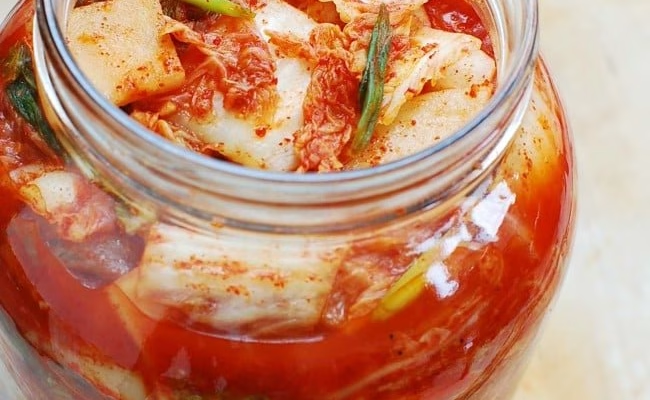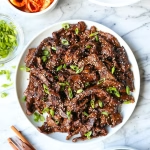
Kimchi, the iconic Korean dish, is more than just a side; it’s a culinary art form bursting with flavor, tradition, and health benefits. This fermented delight, made primarily from napa cabbage and a variety of spices, is renowned for its spicy kick and tangy taste. Not only does Kimchi elevate any meal with its punchy flavor, but it also serves as a probiotic powerhouse, aiding digestion and overall health. In this article, we will explore how to make Kimchi at home, including the essential Kimchi ingredients, variations, and tips to perfect this beloved dish.
By the end of this guide, you’ll confidently whip up your very own batch of homemade Kimchi, whether you like it spicy, mild, or somewhere in between!
Ingredients
| Ingredient | Measurement | Description |
|---|---|---|
| Napa cabbage | 1 large (about 2-3 pounds) | Napa cabbage forms the base of Kimchi, providing a crisp texture and mild flavor that absorbs spices beautifully. |
| Salt | 1/2 cup | Salt is crucial for drawing moisture out of the cabbage and kick-starting the fermentation process, giving Kimchi its signature tang. |
| Garlic | 10 cloves, minced | Fresh garlic enhances the aroma and depth of flavor in Kimchi, adding a spicy warmth that complements the other ingredients. |
| Ginger | 2-inch piece, grated | Ginger contributes a zesty, peppery note that balances the richness of the other flavors in the Kimchi. |
| Red pepper flakes (gochugaru) | 1/2 cup | Gochugaru gives Kimchi its vibrant red color and distinctive heat – adjust the quantity for your spice tolerance! |
| Sugar | 1 tablespoon | Sugar helps to balance the saltiness and heat, promoting fermentation and a bit of sweetness in your Kimchi. |
| Fish sauce | 1/4 cup | Fish sauce adds an umami punch that rounds out the flavors. Vegetarians can substitute with soy sauce or miso. |
| Green onions | 4, chopped | Green onions introduce a fresh, herbaceous note to Kimchi, brightening up the overall flavor. |
| Carrot | 1 large, julienned | Carrots add a touch of sweetness and a nice crunch to the mix. |
Step-by-Step Instructions
- Prepare the Napa cabbage: Start by cutting the cabbage into quarters lengthwise. Remove the core and then cut into bite-sized pieces. Place it in a large bowl and sprinkle with salt. Mix well, ensuring all pieces are coated. Let it sit for about 2 hours, tossing occasionally, until the cabbage is wilted and releases water.
- Rinse and drain: After two hours, rinse the cabbage under cold water to remove excess salt. Drain well and set it aside. This step is crucial to balance the saltiness of your Kimchi.
- Make the Kimchi paste: In a separate bowl, combine minced garlic, grated ginger, red pepper flakes, sugar, fish sauce, and a bit of water to create a thick paste. Mix until smooth and aromatic. This Kimchi sauce is where all the magic happens!
- Add vegetables: Incorporate the chopped green onions and julienned carrots into the Kimchi paste. Mix well, ensuring that the vegetables are evenly coated with the flavorful paste.
- Combine everything: Add the rinsed and drained cabbage to the bowl with the paste. Using your hands (it’s messy but fun!), mix everything together until the cabbage is thoroughly coated. Wear gloves to avoid irritation from the red pepper flakes!
- Pack the Kimchi into jars: Transfer the mixture into clean glass jars, pressing it down firmly to remove air bubbles. Leave some space at the top as the Kimchi will expand during fermentation.
- Ferment: Seal the jars loosely and leave them at room temperature for 1-5 days, depending on your desired level of fermentation. Check daily and taste to find your perfect flavor!
- Store in the fridge: Once fermented to your liking, seal the jars tightly and transfer them to the refrigerator. Your Kimchi can be enjoyed right away and will continue to develop flavor as it sits!
Pro Tips
- Adjust spice levels: Feel free to modify the amount of red pepper flakes based on your heat preference. Start with less and add more if you want it spicier later.
- Experiment with vegetables: While napa cabbage is traditional, feel free to mix in other vegetables like radishes or cucumbers for exciting Kimchi variations.
- Use gloves: When handling the paste, use gloves to protect your hands from the chili and to keep your Kimchi-making process clean.
- Don’t rush fermentation: The longer it ferments, the more complex and tangy the flavors will become. Taste frequently to find your ideal balance!
- Fermentation jars: Use a jar with a wide mouth for easy mixing and cleaning. Special fermentation jars are also available if you’re making large batches.
Nutritional Information
| Nutrient | Value per Serving (1/2 cup) |
|---|---|
| Calories | 23 |
| Protein | 2g |
| Carbohydrates | 4g |
| Saturated Fats | 0g |
| Fiber | 1g |
| Cholesterol | 0mg |
| Sugars | 1g |
| Fat | 1g |
FAQs
What is the best way to store Kimchi?
Store Kimchi in airtight glass containers in the refrigerator. It can last for several months, and as it ferments, the flavor intensifies.
Can Kimchi be made vegan or gluten-free?
Yes! You can easily make a vegan version by substituting fish sauce with soy sauce or miso. Just ensure that the soy sauce is gluten-free if needed!
What are the best side dishes to serve with Kimchi?
Kimchi pairs beautifully with rice, noodles, or grilled meats. It also works great in tacos or as a topping on burgers for a spicy twist!
How long does it take to prepare Kimchi?
Preparation typically takes about 30 minutes, followed by 1-5 days of fermentation, depending on the desired taste and crunchiness.
Can I freeze Kimchi for later?
While you can freeze Kimchi, it may lose some of its crunchiness and texture. It’s best enjoyed fresh or after a day or two of refrigeration!
How spicy is homemade Kimchi compared to store-bought?
The spice level of homemade Kimchi is more customizable. If you prefer a milder taste, simply reduce the amount of red pepper flakes in the recipe!
What should I do if my Kimchi tastes too salty?
If your Kimchi turns out too salty, try rinsing it briefly under cold water and mixing it with additional cabbage or vegetables to balance the flavor.
How do I know when Kimchi is ready to eat?
Kimchi is ready to eat once it has a slightly sour smell and flavor. Taste it daily during fermentation to find your perfect timing!
Making Kimchi at home is a rewarding experience that allows you to customize flavors and spices to your liking. From the vibrant colors to the complex, mouthwatering flavors, it’s a dish that carries cultural significance while being incredibly versatile. We hope you enjoy every step of this cooking adventure!
What are you waiting for? Dive in and give this best Kimchi recipe a try! And if you’ve made this delicious treat, share your experiences or variations in the comments below!






